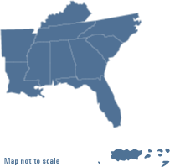Environmental Contaminants
Pollution is one of the American's greatest environmental concerns. The U.S. Fish and Wildlife Service is the primary Federal agency dedicated to protecting wildlife and their habitats from pollution's harmful effects, helping to create a healthier world for all living things.
What We Do
U.S. Fish and Wildlife Service's - Daphne Environmental Contaminants biologists have unique expertise and experience that sets them apart from other biologists in the Service. We are responsible and involved in:
- Oil and chemical spill response,
- Providing technical support,
- Restoring habitats injured by pollution through NRDAR,
- Conducting environmental investigations
Our operations are interwoven with all other Service activities, and we regularly work as partners with other local, state, and federal agencies and non-governmental organizations that have come to rely on our expertise.
Oil and Chemical Spill Response
When an oil or chemical spill occurs, our contaminant biologists are ready to respond to protect our nation's natural resources. During a spill incident, we provide technical expertise to the Federal On-Scene Coordinator to minimize impacts to threatened and endangered species, migratory birds, certain marine mammals, freshwater fish, and their supporting habitat. We also oversee the collection and rehabilitation of oiled and injured wildlife as a result of the spill incident. To ensure a successful and coordinated response effort, we regularly participate in spill response contingency planning and multi-agency response exercises with local, State and other Federal agencies, and with industry.
To find more information on oil and chemical spill response or to report a spill, visit the USFWS-Division of Environmental Quality, National Response Center, EPA, and the Alabama Department of Environmental Management.
Click here to see a video of USFWS's response to Hurricane Katrina

We provide environmental contaminants expertise to all Service programs including the National Wildlife Refuge System, Endangered Species, Migratory Birds, Fisheries, Marine Mammals, and Law Enforcement. Our contaminant biologists are working with EPA, Department of Defense, and other Federal and State agencies responsible for cleaning up contaminated sites by providing invaluable information on sensitive resources and recommendations to ensure that the cleanups protect natural resources for the continuing benefit of the public. We also provide basic research information on the effects of different contaminants (metals, petroleum products, pesticides and other organic compounds) and assist in evaluating risks and fate of those contaminants to fish and wildlife resources.
Natural Resource Damage Assessment & Restoration (NRDAR)
The NRDAR process is used by our contaminant biologists to determine the amount of restoration needed to restore the habitats and resources back to the condition they would have been like had the contaminants not been released and to compensate the public for the lost use and enjoyment of their natural resources.
We are currently involved in NRDAR activities at the following sites: Ciba-McIntosh and Anniston.
For more information on the NRDAR process, visit the Department of Interior's NRDAR Homepage
Our contaminant biologists design and conduct investigations to identify and quantify contaminant impacts to fish and wildlife resources on and off Service lands. The investigations result in specific management recommendations to prevent, reduce, or eliminate these impacts. Investigations are based on sound scientific designs reviewed through a scientific peer review process. Finished reports are then made available to the public and other governmental agencies.


